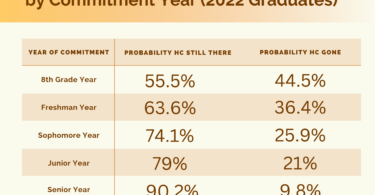We hope that all your hard work will pay off with a scholarship offer from your dream school (or at least from one of your top choices). If you get more than one offer, you are really lucky and you’ll have a tough decision to make! In any case, you may wonder what the process of committing to a program looks like and what happens once you decide to commit.
The Offer
Offers can come in many different ways. Sometimes they will happen on a campus visit, other times they may take place over the phone. It’s important to understand what a scholarship offer is likely to include. Remember, coaches don’t have very many scholarships to offer so they will often divide them up to help more players pay for school. No one really gets a “full ride” because there aren’t that many scholarships to go around. Be realistic about what you might be offered, and talk to your parents about what is best for your family. Once you’ve been offered a scholarship by the coach and you and your parents have had a chance to ask clarifying questions and get the information you need about the offer to make an educated decision, you’ll likely be given a deadline. We talk at length about scholarship offer deadlines here, but it is the period of time the coach has given you to make your decision. Keep in mind that what you tell the coach will be taken very seriously. If you say that you will accept the offer and later change your mind, you’ve put the coach and other players in a bad spot. Take this time to think carefully about the offer and what it will be like to attend the school. Talk to your parents and listen to any concerns that they may have about the costs or the school. Be honest with the coach, whatever you decide.
Accepting the Offer (Verbal Commitment)
If you and your parents decide to accept the coach’s offer, you need to make sure you individually call each and every other coach that was recruiting you and tell them. This is an incredibly important step and you owe it to the coaches who have spent time pursuing you to have that conversation on the phone and thank them for their interest. Beyond being the right thing to do, if your commitment falls apart later, you’ll be thankful you took this step.
Making the Offer Official (Signing)
Verbal commitments are only as strong as the word of the coach who offers them. The terms of your scholarship aren’t officially binding until you sign an NLI or written financial agreement. There used to be two periods during senior year when an NLI could be signed (The Early Signing Period and Regular Signing Period). For recruits in the 2019 class and beyond, the NCAA has changed the NLI signing period. Rather than two separate signing periods, there is now one continuous signing period that extends from November 14, 2018 until August 1, 2019. This will give recruits a much more flexible window to make their final decision throughout senior year. Choosing a school and signing a letter of intent is likely to be one of the most important decisions you have made in your life so far, so it will be very important you understand the NLI and what it means to sign. We lay out those details below.
What is the NLI program?
The NLI program is a voluntary program entered into by most of the DI and DII schools and their prospective student-athletes. By entering into the program and using the National Letter of Intent, schools and prospective student-athletes are agreeing to abide by the rules and guidelines, as governed by the NLI Program.
What is an NLI?
An NLI is a binding agreement between a prospective student-athlete and an NLI member institution (college or university). It is the agreement that guarantees the student-athlete his scholarship offer and guarantees the school that the student-athlete will attend that institution. In essence, it makes the commitment and athletic financial agreement official. You have likely heard about “signing an NLI”. Here’s what that means for both the school and player:
- The prospective student-athlete agrees to attend the institution full-time for one academic year (2 semesters or 3 quarters).
- The institution agrees to provide athletic financial aid (scholarship) for one academic year (2 semester or 3 quarters).
Additionally, once a player has signed an NLI, other member institutions are prohibited from contacting or engaging with the prospective student-athlete or his family. In essence, by signing the NLI, you are ending your recruitment from other schools.
Can a player get out of an NLI?
There is a process by which a player can request a release from the NLI agreement and the NLI becomes null and void if the student-athlete fails to meet criteria specified in the agreement, including failing to be admitted, recruiting violations, and more. If a player decides not to fulfill their NLI agreement without securing a release, they are penalized. The penalty for a student-athlete not fulfilling their signed NLI agreement is having to spend (2 full-time semesters or 3 full-time quarters) at their next NLI member school before being allowed to compete. In other words, the player loses 1 year of competition in all sports.
For the most up to date and comprehensive information on the NLI visit the NLI website HERE.
What is a Signing Period?
As mentioned above, NCAA Division I and Division II programs now have one distinct signing period for each baseball recruiting class. The Signing Period for 2019 graduates lasts from November 14 to August 1st (exact starting dates change each year). Rather than allow for recruits to enter into written financial agreements throughout the entire year, the NCAA provides this (now extended) window when high school seniors can make their verbal commitments official and binding.
What’s the difference between “committing” and “signing”?
We talk a lot about the difference between committing and signing in The Truth About Verbal Commitments, but the main difference is that signing an NLI or a written financial agreement is binding and makes the commitment official. While verbal commitments can be broken on either side, signing binds the player to the institution for a set amount of time. However, it’s important to note that even after signing, things can go wrong. Recruits must abide by the conditions of their written agreement and take steps to ensure they are admitted to school and have met the necessary academic qualifications to play.
For more information on the NLI and signing periods, check out the most up-to-date information here:







